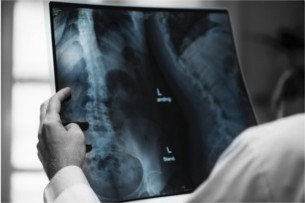Electronic Medical Records
The Electronic Medical Record
Upon entry into any medical facility, the first thing you do is fill out a form with your name, address, insurance coverage, etc. This starts your electronic medical record (EMR) for that visit.
An EMR is a digital record of everything that occurs during a patient’s care and treatment. EMRs are used in clinician offices, clinics, and hospitals. An EMR is a collection of medical information about a person that is stored on a computer.
An Electronic Health Record, or EHR, goes beyond standard clinical data collected in the doctor’s office. An EHR is a systematized collection of patient and population electronically-stored health information in a digital format. These records can be shared across different health care settings. Essentially, it is a group of EMRs. An EHR contains information from all the clinicians involved in a patient’s care. Laboratory and specialist information is also included.
Anyone who has sought care in a medical facility has a digital record of what happened to them at a given facility. These records are used for many purposes, including communicating between medical personnel, billing, generating discharge instructions, and – should it become necessary – telling the story of how you were injured by medical negligence.
A Brief History of the Electronic Medical Record
Electronic Medical Records (EMRs) have been around for years. In 2009, a federal law known as the “HITECH Act” extended privacy and security requirements to electronic data as an extension of the federal HIPAA law. (HIPAA protects private patient information.) As a result of the HITECH Act and other new federal laws, physicians and hospitals were given financial incentives to begin using Electronic Medical Records. In order to receive money from the government, physicians and hospitals were required to use “Certified” EMR technology. The laws dictated what functions the EMRs had to have in order to be considered “Certified.” Among other things, EMR data must be preserved for at least six years, or even longer if the laws in your particular state are more demanding than the federal law.
Why use Electronic Medical Records
The hope for the implementation of electronic medical records was for providers to have easy access to a patient’s health information no matter where the patient was. If a patient who resided in Texas was on vacation in California and in a motor vehicle crash and unable to communicate, the doctors in the California trauma unit could access the patient’s prior medical records. This would allow the doctors to view data such as the patient’s medications and past surgical and medical history, critical pieces of information when treating a trauma patient. Unfortunately, this has not really come to pass. It still remains difficult and time-consuming for one hospital to obtain a patient’s records from another hospital.
The reason a universal database for a patient’s medical records has not materialized is due in large part to unanticipated difficulties with interoperability (“talking between systems”) of different EMR systems. There are well over 1,000 different EMR systems available. These companies did not create their systems to “talk to” other systems. Even if different hospital systems use the same EMR vendor or program, they do not necessarily have the ability to access each other’s records. For example, the Cleveland Clinic utilizes a program called EPIC. Kaiser Permanente also uses EPIC. But, a Cleveland Clinic doctor cannot simply use EPIC to access Kaiser records for a patient, even with the patient’s consent.
To add to the difficulty, hospitals may often use more than one EMR. For example, a hospital may use Meditech for their Emergency Room documentation, McKesson for their inpatient documentation, and Cerner for their lab systems. Although there is some interoperability between these systems in the hospital, it is entirely possible that nurses caring for patients on the floor may not have access to the Emergency Room records. Making the communication more difficult is the fact that some documents, such as anesthesia records and ICU flowsheets, are still handwritten. These are called Hybrid records (both electronic and handwritten documents). The handwritten documents are then scanned into the EMR and the original handwritten document is shredded leaving only a copy of the original. Often the quality of these scanned items lack the clarity and quality of the original document. They also prevent handwriting experts from evaluating the authenticity of the original document.
The good news is that with the advent of large hospital systems (hospitals, doctors’ offices, outpatient clinics, etc.) being owned by the same entity, the trend has been for all care settings owned by the hospital system to use the same EMR or ones that “talk to” each other. For example, if you go to the Emergency Room one day and then follow up with your doctor the following week, your doctor can access your Emergency Room records. This system-wide interoperability also allows your physician to access test results as soon as they are available instead of waiting for them to be faxed or sent via “snail mail.” This only works if your physician is a member (employed by or on the staff of) the large hospital system.
Patients also can access their data via patient portals. After being viewed by the physician, lab work and test results can be added to the portal. Patients can communicate with providers via a portal and even request appointments. It is important, however, for patients to understand that what is uploaded by their doctors to the patient portal is a very small subset of the patients’ actual electronic medical records.
Electronic Medical Records also have other advantages:
- Faster Documentation
- Ability of several providers to access the medical record at the same time. In other words, the nurse doesn’t have to wait for the doctor to be finished with the “chart” before the nurse can document the nursing note or review lab results.
- Patient Safety
- Patient Engagement (Patient Portals)
- Safer medication reviews (medication reconciliation)
- Safer allergy information
- Accurate Billing
- Data Mining: data stored in various electronic medical records can be searched and compiled for various research and quality assurance purposes. For example, a hospital could “mine” its data to see how often surgical patients are re-admitted within 30 days of surgery.
Inputting data into and using an Electronic Medical Record
In general, EMRs allow for faster documentation by using drop down menus, shortcut buttons, and/or templates. These allow providers to simply “point and click” on items instead of typing everything out. Of course, every EMR has the option for the provider to type a “freehand” or narrative note that could include information the “point and click” options don’t offer. EMRs utilize icons to alert nurses that a new order has been placed or alert a provider that a test result is back. EMRs also have a general information screen which – at a glance – shows important data such as allergies and medications. EMRs also have several layers. For example, a physician can click on an order for a chest x-ray and review the order. A second click can allow immediate access to the written interpretation of the x-ray or to the x-ray images themselves. A doctor can easily view a consultant’s note and recommendation or review the nurse notes. EMRs also “autopopulate” certain items. A nurse can enter vital signs under the vital sign section. Those vitals will then appear in several sections of the record at once; for example, on the quick view screen, on the nursing flowsheets, and on the physician’s daily note. There is no need for the nurse to type the same vital signs in three different areas of the chart
Although there are many benefits of electronic medical records, it isn’t all good. There are many aspects of EMRs and their implementation that can lead to patient harm.
Documenting in an EMR: Areas that can Cause Patient Harm
Copy and Paste/Carry Forward
EMRs give providers the ability to copy and paste their previous documentation into their current note. This may seem harmless and timesaving, but can lead to inaccurate notes, inaccurate data, and fraudulent activity. Issues with authorship and accuracy also arise when a provider copies and pastes another provider’s documentation. The copying provider must trust that the documentation by the original author is accurate. Also, by law, the EMR must clearly show the author of each entry. No matter what, even if the information was copied and pasted, when a provider signs a note, he/she is signing that the information contained in the note is true and accurate. They are responsible for the content of the note. Here are a few examples of bad things that can happen when EMRs are used inappropriately.
- A physician was caring for a quadriplegic patient. This patient was in a wheelchair and could not walk. At the first visit, the physician, via “point and click” documentation noted the patient had a “steady gait.” This incorrect information was carried forward for multiple visits, as one physician after another simply cut and pasted the information.
- There was a $3.3 million verdict against a physician’s practice for copying and pasting leading to fraudulent billing activity. A physician can bill a higher charge according to the extent of the data reviewed and documented. A physician was simply copying and pasting data which included past medical history, surgical history, and family history. The physician was NOT reviewing these items at each visit, but due to copying and pasting these items, it appeared the physician had done so. Medicare was billed a higher rate for these visits. Please see https://www.fiercehealthcare.com/it/don-t-let-your-cut-copy-and-paste-use-land-you-fca-hot-water
- There was a $2.4 million verdict against a podiatrist that was won in large part because the doctor copied and pasted previous examinations of a patient’s foot. The information was inaccurate and led to the lack of proper treatment of an infection and an amputation. An expert testified at trial regarding the inaccurate documentation and was able to prove the copying and pasting with the use of an audit trail.
At the Eisen Law Firm, we are acutely attuned to the potential pitfalls of electronic medical records. We have found chart entries that were fraudulently copied and pasted, mistakes that were made because “alerts” weren’t set correctly, and boxes that were “checked” that did not reflect what actually transpired.
Allergies
Patients have been harmed and even died because allergies were not properly entered into the computer system. When an allergy is properly entered into the computer system, it should “autopopulate” to a “quick glance” screen, the physician ordering section, and the pharmacy.
This alerts all involved providers to the allergy.
- A nurse did an admission assessment on a handwritten form, noting an allergy to an antibiotic that caused the patient to nearly die at another hospital. This allergy never got entered into the computer, even though three other allergies did get entered appropriately. An infectious disease physician was consulted and accessed the EMR. He noted the entered allergies and ordered an antibiotic. Unfortunately, he ordered the antibiotic to which the patient was allergic. It was given to the patient, and she had a life -threatening reaction that ultimately caused brain damage. This is a good example of the potential dangers of a hybrid medical records system that sometimes uses electronic records and sometimes uses paper records.
Medication Reconciliation
Upon admission to a hospital, a member of the nursing staff typically is assigned to review all home medications with the patient for accuracy. Due to the EMR, any past medications that had been entered will appear, and the staff member is responsible for making any changes or additions. The same action is to be performed upon discharge, and there is to be clear documentation on the “discharge medication reconciliation” form about which hospital medications are to be stopped and which are to be continued after the patient leaves the facility.
- A patient had hip surgery and was being sent to a nursing home for rehabilitation. She was to be on Lovenox (a medication to prevent blood clots) for another week. The discharging physician failed to include Lovenox on the “discharge medication reconciliation,” and the patient developed a blood clot in her leg. This is a pretty common scenario. The Eisen Law Firm has handled several cases where blood-thinning medications mistakenly were not given, resulting in clots in the legs or in the lungs.
The above examples are not primarily the fault of the EMR, but rather the user of the EMR. There is a saying, “garbage in, garbage out.” The EMR is only as good as the data put into it. However, there have been cases where EMR vendors have been sued because they falsely reported that they had “certified EMR” capabilities. In one case, the vendor (eClinicalWorks) paid $155 million dollars to settle allegations relating to false EMR certification.
(https://www.healthcareitnews.com/news/eclinicalworks-pay-155-million-settle-suit-alleging-it-faked-meaningful-use-certification)
EMR and Medical Malpractice
EMRs are used in lawsuits to provide information regarding what happened to a patient. EMRs are relied upon to represent what happened – even several years later. Often, the electronic record is printed to a paper format and given to the patient when the patient requests their records. Although this provides some of the data in the EMR, it does not represent all the data available in the EMR. Moreover, the printed record lacks hyperlinks and other functionality that is contained in the EMR. For example, you cannot click on a printed page and view an x-ray. Often, thousands of paper pages are provided for review. Attorneys and experts must sift through the pages reorganize them to create a usable timeline regarding care and treatment. For example, the Cerner EMR prints the nurse notes by body system and not by date. Therefore, if the attorney wants to focus on one day’s nurse notes, they must review all the body systems for all the days to obtain data for one day.
Even with the shortcomings of the printed EMR, they are the certified data utilized to build a case. The data is taken from the EMR and placed into a timeline, often called a chronology. This can then give the attorney a clear picture of what happened to a patient and when. Often, when a medical record is given to the attorney by the defendant (produced), it is incomplete, and the attorney must request additional records. For example, the hospital may produce a medical record but may not include scanned documents.
Requesting Medical Records – The first step in a Medical Negligence Case
One of the first steps in a medical malpractice case is to request the medical record. The federal HITECH Act and applicable HIPAA laws allow a patient to request a copy of their medical records contained in the “designated record set.” Unfortunately, each particular facility gets to determine what is included in the designated record set. For example, billing records are often not included in this “designated record set.” Nevertheless, the designated set is typically the starting point for a record review. An experienced medical negligence attorney can review these records to see if your case has merit. After that, the attorney or a hired medical expert can determine whether there are additional records that need to be obtained.
- A patient can request medical records from a doctor’s office or the health information services department of a hospital or medical center. The facility will require the patient to sign a HIPAA release. If you have an attorney, your attorney can prepare a request for your signature and submit it to the doctor or hospital on your behalf. Experienced medical negligence attorneys know how to request records electronically, which most attorneys prefer, as electronic records are much more useful and economical.
- If you request records yourself, you likely will have to pay for the records. If the facility prints the records, they may charge per page, which can get VERY costly. To avoid this, you must specifically state you wish to receive the records electronically, on disk, thumb drive, or by download. The cost for this can be as low as $6.50, even for thousands of pages. Do not allow a facility to insist on paper copies. It is your right, by law, to request these electronically.
- The facility, by law, has 30 days to give you the records. If they don’t, kindly remind them of their 30-day time frame. If they do not give you the records, you have the right to report them to the U.S. Department of Health and Human Services, Office of Civil Rights.
(http://www.hhs.gov/civil-rights/filing- complaint/complaint-process) - You also may have access to patient portal information. It is prudent to print information such as test results and e-mail exchanges from this portal if it is pertinent to your case.
- Request all x-rays, CT scans, MRIs, etc. to be exported to a disc if these items are pertinent to your case. Separate requests may have to be made to a hospital’s radiology department for these studies and separate fees will apply.
- You, as a patient or the legal representative, have the right to request an “Accounting of Disclosures”. This is a list of everywhere your medical record was sent. Your attorney cannot do this. This can be especially important if your attorney suspects there has been medical record tampering/alteration. For example, if the day after your Emergency Room visit, the records were sent to your Primary Care physician, and you suffered negligence during that Emergency Room visit, it would be prudent to obtain the records from your Primary Care Physician to compare records.
- If you are considering a lawsuit, obtain your records as soon as possible, or better yet, see an attorney as soon as possible, so the attorney can obtain the records for you. Requesting records will not affect your ability to receive care at the facility or provider. Also, request your records from ALL providers involved, even if you aren’t considering a lawsuit against them. For example, if a pressure injury (bedsore) started in a nursing home, get all treating records. Get the hospital records when you had to be admitted for treatment of the infected bedsore, even though you are not suing them. Get the wound clinic records, even though you are not suing them.
- If you are considering a lawsuit, do not wait to find an attorney, as there may be other crucial data needed for your case that is not included in the medical record and not protected by preservation requirements under HIPAA. For example, there is technology, such as RFID devices and GPS locators, used by hospitals and nursing homes to track staff activity. This data, if utilized by a facility, can track how long a call bell was ringing or exactly when a specific nurse entered the patient’s room. This data can be crucial for many kinds of medical negligence cases. However, there is no law dictating how long a facility must maintain this data. For that reason, the sooner you retain an attorney, the better.
The Electronic Medical Record is not new, but such records are becoming more pervasive and are continually developing more functions. They can be the key to your medical negligence case, so it is important to find a lawyer who understands how these records are maintained and retrieved.




